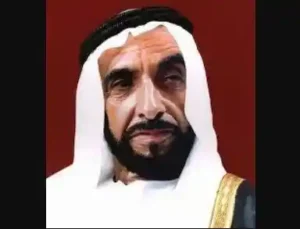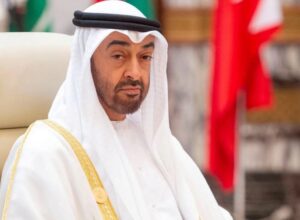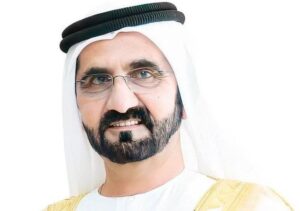Presidents That Have Ruled The United Arab Emirate to Date
| Role | First President | Current President | Current VP |
|---|---|---|---|
| Name | Sheikh Zayed bin Sultan Al Nahyan | Sheikh Mohamed bin Zayed Al Nahyan | Sheikh Mohammed bin Rashid Al Maktoum |
| Years of Tenure | 1971-2004 | 2022-present | 2006-present |
| Origin | Al Ain, Abu Dhabi | Al Ain, Abu Dhabi | Dubai, UAE |
| Previous Positions Held | Ruler of Abu Dhabi (1966-2004) | Crown Prince of Abu Dhabi (2004-2022) | Ruler of Dubai (2006-present) |
READ ALSO: Prime Ministers That Have Ruled Malaysia Till Date
First President of the UAE: Sheikh Zayed bin Sultan Al Nahyan

Years of Tenure: 1971-2004
Origin: Sheikh Zayed was born in Al Ain, which is part of the Emirate of Abu Dhabi. His lineage traces back to the Al Nahyan family, who have historically been rulers of Abu Dhabi.
Previous Positions Held: Before becoming the President of the UAE, Sheikh Zayed served as the Ruler of Abu Dhabi from 1966. His leadership in Abu Dhabi set the stage for his role in unifying the Emirates.
Notable Achievements:
- Founding of the UAE: Sheikh Zayed was instrumental in the formation of the United Arab Emirates in 1971, bringing together seven emirates into a single nation. This unification marked the beginning of a new era of stability and development in the region.
- Economic and Infrastructure Development: Under his leadership, the UAE saw significant advancements in infrastructure, including roads, schools, and hospitals. His vision was pivotal in transforming the UAE from a largely desert region into a modern state with a high standard of living.
- Environmental Initiatives: Sheikh Zayed was ahead of his time in promoting environmental conservation. His efforts included reforestation programs and the establishment of protected wildlife areas, which laid the groundwork for ongoing environmental policies in the UAE.
Downsides:
- Limited Political Reforms: Despite his modernization efforts, Sheikh Zayed’s tenure was characterized by a lack of political reforms. The political structure remained largely traditional, with limited avenues for political participation outside the ruling families.
- Slow Pace of Political Liberalization: The pace of political liberalization under his rule was gradual. While economic and infrastructural changes were significant, political reforms and greater democratic processes were not a priority during his tenure.
Current President of the UAE:

Years of Tenure: 2022-present
Origin: Sheikh Mohamed was born in Al Ain, Abu Dhabi. He is the third son of Sheikh Zayed and has been groomed for leadership from an early age.
Previous Positions Held: Before becoming President, Sheikh Mohamed served as the Crown Prince of Abu Dhabi starting in 2004 and was the Deputy Supreme Commander of the UAE Armed Forces. His role in these positions allowed him to shape UAE policy and military strategy significantly.
Notable Achievements:
- Economic Diversification: Sheikh Mohamed has focused on continuing the economic diversification of the UAE. His leadership emphasizes moving away from oil dependency and investing in technology, renewable energy, and other sectors.
- Strengthening International Alliances: Under his presidency, the UAE has worked on strengthening its global relationships. His efforts include deepening ties with countries in Europe, Asia, and the Americas, enhancing the UAE’s role on the international stage.
- Innovation and Technology: Sheikh Mohamed has promoted innovation as a key pillar of the UAE’s future. Initiatives like the establishment of tech hubs and investments in artificial intelligence reflect his commitment to positioning the UAE as a leader in technological advancement.
Downsides:
- Economic Challenges: The UAE faces significant economic challenges, including the impacts of global economic fluctuations and regional tensions. While diversification efforts are ongoing, the country’s economic stability is tested by these factors.
- Regional Tensions: Sheikh Mohamed’s tenure has been marked by involvement in regional conflicts and tensions. Balancing domestic priorities with regional diplomacy remains a complex challenge.
Current Vice President of the UAE:

Years of Tenure: 2006-present
Origin: Sheikh Mohammed was born in Dubai. He is the third son of Sheikh Rashid bin Saeed Al Maktoum, the previous ruler of Dubai.
Previous Positions Held: Before becoming Vice President, Sheikh Mohammed served as the Crown Prince of Dubai starting in 1995 and was the Prime Minister of the UAE from 2006. His roles have been pivotal in shaping Dubai’s global stature.
Notable Achievements:
- Major Infrastructure Projects: Sheikh Mohammed is known for spearheading significant infrastructure projects in Dubai, including the Burj Khalifa, Palm Jumeirah, and the Dubai Metro. These projects have solidified Dubai’s position as a global city.
- Expo 2020: His vision led to Dubai hosting Expo 2020, which was a milestone event for the UAE, showcasing its capabilities and innovation on a global platform.
- Economic and Social Reforms: Sheikh Mohammed has introduced numerous reforms aimed at enhancing Dubai’s business environment and social policies, including initiatives to boost entrepreneurship and improve public services.
Downsides:
- Human Rights Concerns: Sheikh Mohammed’s administration has faced criticism regarding human rights issues, including concerns over freedoms of speech and press. The UAE’s record in these areas has been a point of contention internationally.
- Economic Disparities: Despite the wealth generated by Dubai’s growth, there are ongoing concerns about economic disparities and the impact of rapid development on different segments of society.
